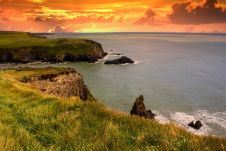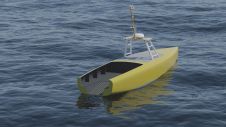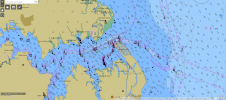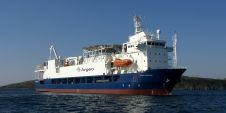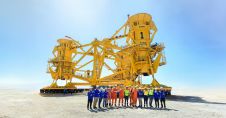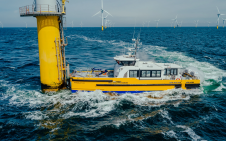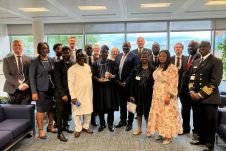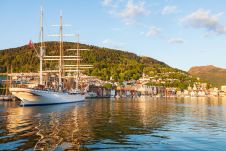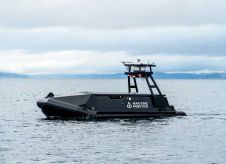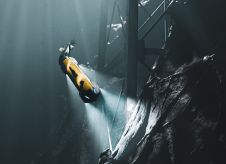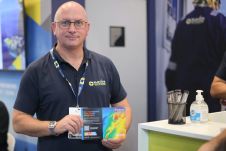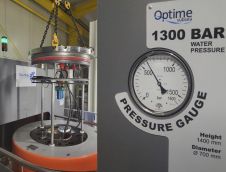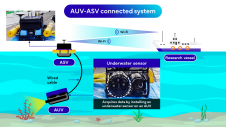The evolution of Dutch hydrography
From historical struggles to present-day advances in navigation
Given the Netherlands’ geographical location, it is unsurprising to find it has a long tradition of hydrography. The lowland, often below sea level, forms a delta where major rivers from Central Europe flow into the North and Wadden Seas. While the Dutch have a centuries-long history of pioneering in hydrography, the establishment of a national hydrographic service occurred relatively recently, in 1874. This article delves into the history of Dutch hydrography, highlighting the eternal struggle of the Dutch against water, and zooms in on today’s innovative hydrographic sector.
The Netherlands is situated at the confluence of the Rhine, Meuse, Scheldt and Ems rivers, which flow directly or indirectly into the North Sea. The country also has an intertidal zone in the south-eastern part of the North Sea, known as the Wadden Sea. The geographical location of the Netherlands poses a significant challenge for engineers. In essence, storms can drive North Sea water towards the coast while rivers are also attempting to discharge excess water, exerting considerable pressure on river dikes. Such circumstances highlight the vulnerability of the Netherlands and the crucial importance of effective water management in the country.
Besides its geographical location, another cornerstone of Dutch hydrographic expertise stems from its maritime legacy. As a long-standing maritime powerhouse, the Netherlands has relied on shipping for many centuries, which has fostered safety and prosperity. Since its establishment in 1874, the Hydrography Department of the Royal Netherlands Navy has been entrusted with various hydrographic, meteorological and navigational responsibilities, including the production of nautical charts, descriptions, guides and announcements for seafarers. Throughout history, the Navy has diligently protected Dutch maritime territories, coastal regions, ports and shipping lanes, inherently integrating hydrographic tasks into its broader maritime security mandate.

Dutch hydrographic pioneers
The prominent role of the Dutch in 16th-century European trade necessitated advances in navigational instruments beyond what was available. Notably, Lucas Janszoon Waghenaer (1533–1606) and Aelbert Heyen (ca. 1550–ca. 1613) made significant contributions in this regard. Waghenaer in particular is hailed as a pioneering figure in the establishment of safer sea routes along the European coasts. His work, Spieghel der Zeevaerdt, published in 1584 and in English under the name The Mariner’s Mirror, marked a significant leap forward in maritime cartography. This groundbreaking sea atlas included charts, sailing directions, coastal views and navigational tables covering the European coasts from Gibraltar to North Cape, revolutionizing maritime navigation. Waghenaer’s extensive collection of maps was largely standardized in scale and employed consistent symbols for landmarks, beacons and small villages, delineating shoals with dots encircled by double dotted lines and utilizing hatching to denote coastlines.
Other advances in the 16th century laid the foundation for the hydrographic profession. In 1533, the cartographer Gemma Frisius proposed using triangulation to accurately position distant locations for map-making. One of his notable students, Gerardus Mercator, later gained global recognition for his cylindrical projection system, ensuring angular fidelity on nautical charts for the first time. Mercator’s most renowned achievement was the development of the 1569 world map using this projection, which depicted sailing courses of constant bearing, known as rhumb lines, as straight lines. This pioneering system continues to be employed on modern nautical charts. Willebrord Snel van Royen, better known as Snellius, was another brilliant mind of his time. His expertise spanned geodesy, navigation, hydrography and astronomy. Born in 1580 and living until 1626, he gained renown for his precise measurement of the distance between the Dutch towns of Alkmaar and Bergen op Zoom using triangulation. Snellius is widely regarded as one of the pioneers of geodesy.
Atlas Maior
In 1635, Joan Blaeu, a distinguished publisher from Amsterdam, released the two-volume Atlas Novus. This cemented Blaeu’s status as the official cartographer of the Dutch East India Company. Known for his deep interest in hydrography, Joan Blaeu played a significant role in the development of maritime cartography. The Atlas Novus became increasingly comprehensive in subsequent editions. Eventually, in 1662, the monumental Atlas Maior was published. Spanning 11 volumes and featuring 600 maps, the Atlas Maior was widely considered a masterpiece of the Golden Age of Dutch cartography, comprehensively compiled as a multi-part world atlas. This achievement solidified Blaeu’s status as a pre-eminent cartographer and publisher of his time.

While widely recognized for his expertise, Blaeu also occasionally caused frustration. This sentiment prompted the Zeeland chamber of the Dutch East India Company to commission its own cartographers from 1669 onward. Among the grievances were complaints about the high prices charged by Joan Blaeu for his manuscript maps, prompting the Zeelanders to establish their own hydrographic survey and mapping service.
Several other Dutch cartographers have significantly contributed to the enhancement of maps and hydrographic knowledge. Noteworthy among them are Johannes van Keulen and his lineage, esteemed for their production of sea atlases in the 17th century, along with Jodocus Hondius, who played a pivotal role in the English edition of Waghenaer’s Spiegel der Zeevaerd.

Hydrography after Napoleon
After the Napoleonic era, often referred to as the French era in the Netherlands, Europe experienced significant geopolitical change. The Congress of Vienna, convened from September 1814 to June 1815, marked a crucial turning point for the continent. Initially, the Netherlands merged with Belgium to form the Kingdom of the Netherlands. However, from 1830 onward, both nations pursued separate paths. The Netherlands, once a dominant force during the Golden Age, found itself in a period of stagnation, prompting a need for reinvention. A similar trend can be observed in its pursuits in hydrography.
As early as 1787, the government had initiated scientific planning for hydrographic research. However, following the establishment of the Kingdom of the Netherlands in 1815, the systematic exploration of Dutch coastal waters and estuaries commenced, extending until 1874. Throughout this era, the government made a concentrated effort to formalize and organize hydrographic research.
Between 1815 and 1825, extensive exploration and mapping projects were conducted in the estuaries of Zeeland province and other Dutch coastal regions. This effort later expanded to include other areas. Notably, a comprehensive survey of the Zuiderzee, a North Sea inlet, was carried out from 1844 to 1845, resulting in the detailed mapping of crucial waterways.
In 1815, Minister of the Navy J.C. van der Hoop recognized the need for updated coastal observations due to complaints about outdated maps. Introducing innovative techniques, precise mapping was achieved through advanced triangulation methods along the coastline. The resulting hydrographic map of the Netherlands set the standard throughout the 19th century. Based on the publication of foreign maps depicting the coastal waters of the Netherlands, alongside Dutch hydrographic mapping activities, it became evident that the country was reclaiming its prominence in this domain.
1874 to 1980, an era marked by the institutionalization and internationalization of hydrographic research, began with the establishment of hydrography as a department within the Navy in 1874. The core objective of the Navy’s hydrographic service was precision through meticulous measurement. Each endeavour entailed measuring ocean depths while simultaneously pinpointing the precise geographical coordinates of surveyed points. This meticulous process relied on specialized instruments such as sounding devices, sextants and time meters. Furthermore, the strategic placement of beacons was executed with precision, with their geographic coordinates established accurately before deployment as reference points for measurement.
Initially, the three focus areas were Dutch coastal waters and maritime areas and coastal waters in the East and West Indies. The recording and mapping of coastal waters and estuaries in the Netherlands were largely completed in the first half of the 19th century. Notably, Dutch survey vessels were continuously active in the colonial waters of the vast area now known as Indonesia from 1858 until their activities were interrupted by the war with Japan in 1942.
Game-changing events in the 20th century
Two flood disasters in the 20th century starkly illustrated the dire consequences of the neglected maintenance of dikes and waterworks in the Netherlands. These events spurred the implementation of the Zuiderzee Works and the Delta Works, monumental endeavours aimed at safeguarding the Netherlands from future water-related catastrophes. Today, these projects remain among the most remarkable feats in the field of civil engineering worldwide.
Zuiderzee Works
Initial plans for the Zuiderzee Works date back to 1850, but it was not until the devastating flood of 1916 that the Zuiderzee Act of 1918 was passed, kickstarting the realization of engineer Cornelis Lely’s vision. Lely, who also served as Minister of Water Management, meticulously conducted numerous studies on water depth and soil composition prior to formulating his plan. His visionary approach was ahead of its time, setting a new standard in engineering.
In essence, the Zuiderzee Works entailed Lely’s proposal to block off the Zuiderzee – an inland sea or, more accurately, a North Sea inlet – from the ocean with a dam. This would transform the inland sea into a vast freshwater lake, with portions of it reclaimed for land. Engineers initially greeted Lely’s ambitious plans with considerable scepticism, questioning their technical feasibility and debating their utility and necessity, though attitudes shifted following the 1916 flood. Despite these challenges, Cornelis Lely persisted, buoyed by the support of the Zuiderzee Association and an unwavering determination. This association appointed engineer Cornelis Lely as a key adviser, who wrote a series of highly valuable technical papers. He possessed broad knowledge and a sharp understanding of hydraulic engineering works, and the present project closely aligns with his proposals.

Cornelis Lely began preparations for the Zuiderzee Works as early as the summer of 1887, focusing on terrain research, soil drilling and soundings in the Zuiderzee. These early explorations were conducted aboard a sailing ship, primarily targeting the northern region of the Zuiderzee floor. Using a simple dipstick, Lely drilled into the seabed to assess soil types based on the sound and depth of penetration as he sought to identify the most suitable areas for reclamation. He meticulously preserved soil samples, which he later brought along on subsequent tours of the Zuiderzee.
A significant challenge emerged during the intense preparations for the implementation of the Zuiderzee Works around 1921. This was a lack of sufficient tidal information, particularly in the northern part of the Zuiderzee, for which urgent measurements were required. However, the absence of suitable self-registering tide gauges for open sea conditions posed a problem. To address this, the Zuiderzee Association innovatively developed solutions using existing components. Despite these efforts, only a limited amount of reliable data was collected that could be used as input for the model calculations.

Delta Works
Another remarkable Dutch engineer who undoubtedly equalled Lely in merit was Johan van Veen. However, it is striking that the preface to his biography begins with the poignant statement: “Before you is a captivating biography of one of the greatest Dutchmen of all time: Johan van Veen. [...] Yet, despite his accomplishments, most Dutch people remain unfamiliar with his name.”
On 1 February 1953, over 150 breaches occurred in the dikes across the Netherlands as the North Sea unleashed its fury. Johan van Veen had been sounding the alarm about this impending disaster for years, but his concerns about the state of the Dutch dikes went largely ignored. Although he held the position of chief engineer at Rijkswaterstaat, he was subordinate to two superiors and his innovative approach to assessing the condition of the dikes left his bosses sceptical and unsure. This poses important questions about the effectiveness of our current methods and the need to heed expert advice in safeguarding against potential risks and challenges.
Johan van Veen rightfully earns the distinguished title of ‘architect of the Delta Works’. He was a self-taught pioneer who was far ahead of his time, recognizing the threat of sea-level rise as early as the 1930s, based on his observation of storm surge levels and the height of average tidal rises. Prior to the invention of computers, calculating tides was a time-consuming process that required manual labour. To expedite the process, hydraulic engineers sought more efficient and reliable alternatives. Johan van Veen played a pivotal role in this development by introducing the electric-hydraulic analogue for tidal calculations. He further refined his method during World War II and experimented using copper wires, capacitors and other instruments. These experiments resulted in the Deltar, one of the first Dutch computers, which provided unprecedented speed and power for calculating the hydrological effects of the closure of the Dutch delta area.
The Deltar, which stands for Delta Tide Analogue Calculator, was used in the design and execution of the Delta Works from 1960 to 1984. Johan van Veen built the initial prototypes of the Deltar between 1944 and 1946, and his work was continued by J.C. Schönfeld and C.M. Verhagen after his death in 1959. It is highly likely that without the rapid tidal calculations provided by the Deltar, the Delta Works could not have been carried out as quickly as they were after the February disaster of 1953.
The stature of Johan van Veen can perhaps best be illustrated by the fact that his work is still used as lecture material. One such example is the Scheldt study, conducted in 1944–1945, which is a comprehensive examination of various factors that include changes in river channels and depths, the deepening of the river mouth, and the impact of land reclamation on the river’s flow. Additionally, the study explores the interaction between the river and storm surges. While the research had been forgotten for many years, it resurfaced in the 1990s when the Dutch Ministry of Infrastructure and Water Management’s subsidiary Rijkswaterstaat began a study of the Scheldt estuary. Strikingly, the approach to the two studies was highly similar, despite the half-century gap between them. This is further evidence of Johan van Veen’s forward-thinking and innovative approach.

Modern Dutch hydrography
In the era following World War II, hydrography in the Netherlands burgeoned into a profession of paramount importance. This ascent paralleled the growing economic significance of the maritime sector, underscored by the Netherlands’ prominent position as a global leader in hydraulic engineering. Notably, the international acclaim garnered by Dutch hydraulic engineering received an immense boost from the monumental Delta Works project.
At the forefront of this renaissance were esteemed Dutch companies such as Arcadis, Boskalis, Royal HaskoningDHV and Van Oord – renowned worldwide for their unparalleled expertise in flood protection and hydraulic engineering. Their pioneering contributions have not only solidified the Netherlands’ reputation as a hub of maritime innovation but have also propelled the nation onto the global stage as a trail-blazer in water management solutions.
In this context, the role of the Hydrographic Service of the Royal Netherlands Navy has assumed newfound significance. Tasked with the crucial responsibility of mapping the ever-evolving contours of the ocean depths, the service plays a vital role in ensuring the safety and efficiency of maritime navigation. Moreover, its contributions extend beyond mere cartography, encompassing a broader mandate of environmental stewardship and sustainable development in the maritime domain.

In the dynamic world of maritime affairs, the Netherlands maintains a steady focus on advancing hydrography and hydraulic engineering. The Hydrographic Service embodies qualities of innovation, resilience and unwavering dedication. It serves as a reminder of the nation’s enduring maritime heritage and its commitment to fostering a safer, more sustainable future on the high seas.
The Dutch hydrographic standards are based on the S-44 standards set forth by the International Hydrographic Organization (IHO), with additional specifications tailored to the unique conditions found in the Netherlands. These stricter requirements particularly focus on coastal defence, morphological research, environmental considerations and the management and maintenance of inland waterways. As one of the founding countries of the IHO, the Netherlands has played a pivotal role in shaping its development.
Education in a transforming hydrographic sector
The success of Dutch maritime engineering relies heavily on the expertise of skilled hydrographers. In 2002, the hydrography course at the Amsterdam University of Applied Sciences was discontinued. NHL Stenden University of Applied Sciences subsequently took over the programme, relocating it to the Maritime Institute Willem Barentsz (MIWB) on the island of Terschelling, one of the West Frisian Islands. Renowned for its exceptional facilities, MIWB boasts modern measuring equipment, simulators and training vessels tailored for comprehensive practical training. A key promotional point of the institute emphasizes the promising career prospects facilitated by the scarcity of skilled professionals in the field – a challenge not only internationally but also within the Netherlands’ maritime sector. After all, the work of hydrographers holds immense significance, directly impacting dredging operations and offshore activities, thereby influencing their feasibility and success.

The programme has been rebranded as Ocean Technology, and is the only programme in the Netherlands certified at the highest international hydrographic standard (Cat A). Students receive exceptional instruction in their chosen field, cementing the programme’s reputation. For instance, students engage in depth measurements at sea and the highly accurate mapping of seabed structures as hydrographers. Their responsibilities encompass project preparation, installation of equipment aboard measuring vessels, data collection and subsequent analysis and synthesis of data into maps and reports.
As the venue for hydrographic training shifted in the Netherlands, so too did the backdrop against which significant innovations in the field emerged. The oil and gas boom in the North Sea gave rise to a new nautical branch: civil hydrography. This development brought forth heightened demands for accuracy, reliability and speed in data processing, leading to the introduction of precise surface and underwater navigation systems. Dutch companies have played a pivotal role in driving advancements in data automation and processing, with a strong emphasis on quality assurance – a sentiment echoed by Prof. J.A. Spaans, a key figure in shaping the hydrography curriculum in Amsterdam.
Hydrography is currently undergoing significant transformation and facing challenges, a trend mirrored not only in the Netherlands but also in other regions with robust hydrographic sectors. Particularly vital in mapping the seabed for wind turbine installation and maintenance, hydrography’s future is intertwined with sustainable energy transitions and technological advancements.
The field is evolving alongside cutting-edge technologies, with vessels equipped with advanced hydrographic instruments, enhancing data collection efficiency and map production. This translates to expedited and more precise navigation, crucial for both maritime shipping and submarine infrastructure development. An evident testament to this evolution is the escalating adoption of autonomous hydrographic platforms.
The rapid integration of advanced technologies within the hydrographic sector promises to revolutionize data collection and map production, catalysing innovation. This transformative landscape inevitably influences hydrographic education, prompting the Maritime Institute Willem Barentsz to align its training closely with industry demands.

Today’s hydrographic sector
The Netherlands has a robust international presence in hydrography, marine geophysics and oceanography. This prominence is fuelled by collaborative efforts among Dutch companies who pool resources to deliver a diverse array of ocean-related services and products. Leveraging their collective expertise, these companies offer comprehensive solutions to global demands in oceanographic monitoring, surveying and forecasting. The Netherlands’ prowess in this domain is often showcased at prominent events such as Oceanology International and Ocean Business, where the Dutch pavilion serves as a testament to its collective capabilities. While Fugro enjoys widespread recognition worldwide, other Dutch companies such as Geo Plus and Braveheart have also earned international acclaim for their esteemed hydrographic surveying, inshore, nearshore and offshore support and crew tendering services.
Numerous esteemed Dutch companies excel in hydrography, marine geophysics and offshore precise positioning. Deep BV is a prime illustration, providing bespoke services tailored to offshore, coastal zones, seaports and inshore waterways. But the Netherlands is also known for companies that develop highly innovative hardware and software solutions for capturing and processing hydrospatial data.

Demcon Unmanned Systems, a Dutch company, is an excellent example of the transformative shifts in modern hydrography. At the forefront of electric autonomous unmanned vessels, Demcon exemplifies an unwavering commitment to safer, sustainable, efficient and cost-effective maritime operations. Manufacturing vessels poised for a future of maritime automation, the company heralds the emergence of autonomous uncrewed survey vessels (USVs). These technological marvels not only redefine safety standards but also pave the way for eco-responsible practices in the industry.
Of course, Fugro is also known for its contributions to a new generation of USVs in the Netherlands. Designed for hydrographic and geophysical surveys, offshore asset inspections and construction support services, these vessels signify a shift towards remote and autonomous mapping. The importance of this transition is highlighted by Fugro’s acquisition of SEA-KIT International, an innovative developer of USVs recognized for its low carbon emission maritime operations and research.
Software providers such as QPS play a vital role in the maritime industry, offering advanced solutions in geomatics software and services. Their comprehensive offerings cover the entire workflow, serving both surveyors and pilots. Similarly, BeamworX, a prominent software engineering and consultancy company, focuses on the hydrographic surveying and offshore market. Specializing in the acquisition, processing and integration of single and multibeam echosounder data, BeamworX contributes significantly to technological advancements in this field.
Across generations, the Netherlands has harboured a profound connection to maritime pursuits, its heritage deeply rooted in the sea. Over centuries, Dutch companies have meticulously refined their skills in offshore operations, acquiring an unparalleled understanding of the nuanced conditions above and below the sea surface that significantly influences project outcomes. This extensive experience has established the Netherlands as a premier global centre for pioneering offshore wind businesses, maritime enterprises and esteemed research institutes, renowned for their remarkable achievements and groundbreaking innovations worldwide.
However, with this esteemed position comes a profound responsibility to safeguard this reputation for future generations. The Netherlands remains committed to upholding the highest standards of maritime excellence, ensuring sustainable practices and continued innovation to preserve its legacy as a leader in the maritime industry.


Value staying current with hydrography?
Stay on the map with our expertly curated newsletters.
We provide educational insights, industry updates, and inspiring stories from the world of hydrography to help you learn, grow, and navigate your field with confidence. Don't miss out - subscribe today and ensure you're always informed, educated, and inspired by the latest in hydrographic technology and research.
Choose your newsletter(s)

